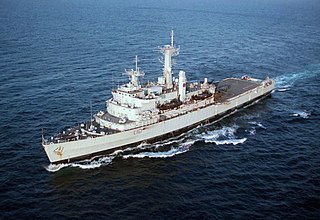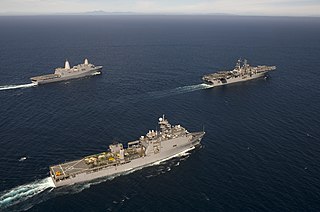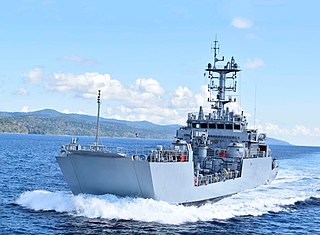
INSVikrant was a Majestic-class aircraft carrier of the Indian Navy. The ship was laid down as HMS Hercules for the British Royal Navy during World War II, but was put on hold when the war ended. India purchased the incomplete carrier in 1957, and construction was completed in 1961. Vikrant was commissioned as the first aircraft carrier of the Indian Navy and played a key role in enforcing the naval blockade of East Pakistan during the Indo-Pakistani War of 1971.

The Tarawa class is a ship class of Landing Helicopter Assault (LHA) type amphibious assault ships operated by the United States Navy (USN). Five ships were built by Ingalls Shipbuilding between 1971 and 1980; another four ships were planned, but later canceled; instead they were joined by the Wasp-class amphibious assault ships.

HMS Fearless (L10) was a Royal Navy amphibious assault ship that served from 1965 until 2002. One of two Fearless-class landing platform docks, she was based in HMNB Portsmouth and saw service around the world over her 37-year life. She was the last steam-powered surface ship in the Royal Navy.

Landing craft are small and medium seagoing watercraft, such as boats and barges, used to convey a landing force from the sea to the shore during an amphibious assault. The term excludes landing ships, which are larger. Production of landing craft peaked during World War II, with a significant number of different designs produced in large quantities by the United Kingdom and United States.

The Landing Craft, Tank (LCT) was an amphibious assault craft for landing tanks on beachheads. They were initially developed by the Royal Navy and later by the United States Navy during World War II in a series of versions. Initially known as the "tank landing craft" (TLC) by the British, they later adopted the U.S. nomenclature "landing craft, tank" (LCT). The United States continued to build LCTs post-war, and used them under different designations in the Korean and Vietnam Wars.

A Landing Ship, Tank (LST) is a ship first developed during World War II (1939–1945) to support amphibious operations by carrying tanks, vehicles, cargo, and landing troops directly onto a low-slope beach with no docks or piers. The shallow draft and bow doors and ramps enabled amphibious assaults on almost any beach.

A Landing Craft Utility (LCU) is a type of boat used by amphibious forces to transport equipment and troops to the shore. They are capable of transporting tracked or wheeled vehicles and troops from amphibious assault ships to beachheads or piers.

USS Epping Forest (LSD-4/MCS-7) was an Ashland-class dock landing ship acquired by the U.S. Navy during World War II for duty in the Pacific Theater. Her task was to carry and land amphibious landing craft and other equipment and to recover and repair landing craft when possible. Named for an estate in Lancaster County, Virginia where Mary Ball Washington, mother of George Washington, was born, she was the only U.S. Naval vessel to bear the name.

An amphibious warfare ship is an amphibious vehicle warship employed to land and support ground forces, such as marines, on enemy territory during an amphibious assault.

The Abhay-class corvettes of the Indian Navy are the customised variants of the Soviet Pauk-class corvettes. The class was primarily intended for coastal patrol and anti-submarine warfare. The last ship of the class is expected to be decommissioned by 2025. The class is being replaced by Arnala-class and Mahe-class of Anti-Submarine Warfare Shallow Water Craft. The ships formed the 23 Patrol Vessel Squadron of the Indian Navy.

Kumbhir-class landing ships are medium amphibious warfare vessels of the Indian Navy.
Arnala class was an Indian designation for the Petya III-class vessels of the Indian Navy.

INS Jarawa is a naval base of the Indian Armed Forces under the joint-services Andaman and Nicobar Command located in Port Blair in the Andaman & Nicobar Islands. It was commissioned in 1964.

INS Saryu is the first Saryu-class patrol vessel of the Indian Navy, designed and constructed indigenously by the Goa Shipyard Limited. The ship is home-ported at Port Blair, under the Andaman and Nicobar Command (ANC). She is the largest offshore patrol vessel in the navy.

Mk IV LCU class vessels follow on class of Mk. III LCU operated by the Indian Navy. The Mk IV LCU can be deployed for maritime roles that require amphibious capabilities.
Rear Admiral Arun Auditto, AVSM, NM was a Flag Officer in the Indian Navy. He was decorated with a gallantry award during the Liberation of Goa. A pioneer submariner in the Indian Navy, he was the commissioning Commanding Officer of the Kalvari-class submarine INS Kursura (S20), which he commanded during the Indo-Pakistani War of 1971. He later commanded the submarine base INS Virbahu and the Whitby-class frigate INS Trishul (F143). After promotion to flag rank, he served as the Fortress Commander, Andaman and Nicobar Islands (FORTAN) and as the first Flag Officer Submarines, before retiring in 1988.














